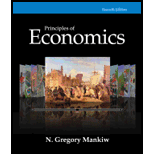
Subpart (a):
Calculate total revenue and marginal revenue.
Subpart (a):
Explanation of Solution
Table – 1 shows the schedule of market
Table – 1
|
| Quantity |
| 24 | 10,000 |
| 22 | 20,000 |
| 20 | 30,000 |
| 18 | 40,000 |
| 16 | 50,000 |
| 14 | 60,000 |
Total revenue is calculated using the following formula:
Substitute the respective values in Equation (1) to calculate the total revenue at quantity of 10,000 units.
Thus, total revenue is $240,000.
Marginal Revenue is calculated using the following formula:
Substitute the respective values in Equation (2) to calculate the marginal revenue at the output level of 20,000 units.
Thus, the marginal revenue is $20.
Table – 2 shows the calculation of Total Revenue and Marginal Revenue obtained by using Equations (1) and (2).
Table – 2
| Price | Quantity | Total Revenue | Marginal Revenue |
| 24 | 10,000 | 240,000 | - |
| 22 | 20,000 | 440,000 | 20 |
| 20 | 30,000 | 600,000 | 16 |
| 18 | 40,000 | 720,000 | 12 |
| 16 | 50,000 | 800,000 | 8 |
| 14 | 60,000 | 840,000 | 4 |
Concept introduction:
Total revenue: Total revenue is derived by multiplying the price with total quantity sold.
Marginal revenue: Marginal revenue is the additional revenue generated due to sale of one unit of output.
Subpart (b):
Total cost and marginal cost.
Subpart (b):
Explanation of Solution
Total cost is calculated using the following formula:
Substitute the respective values in Equation (3) to calculate the total cost at 10,000 units of output. Since, the firm has only variable cost, the cost is $5.
Total cost is $50,000.
Thus, the total cost is $50,000.
Marginal Cost is calculated using the following formula:
Substitute the respective values in Equation (4) to calculate the marginal cost.
Thus, the marginal cost is $20.
Profit is calculated using the following formula:
Substitute the respective values in Equation (4) to calculate the profit at 10,000 units.
Thus, the profit is $190,000.
Table -3 shows the Total Cost and Profit obtained by using Equations (3) and (4).
Table -3
| Price | Quantity | Total Revenue | Marginal Revenue | Total Cost | Marginal Cost | Profit |
| 24 | 10,000 | 240,000 | - | 50,000 | - | 190,000 |
| 22 | 20,000 | 440,000 | 20 | 100,000 | 5 | 340,000 |
| 20 | 30,000 | 600,000 | 16 | 150,000 | 5 | 450,000 |
| 18 | 40,000 | 720,000 | 12 | 200,000 | 5 | 520,000 |
| 16 | 50,000 | 800,000 | 8 | 250,000 | 5 | 550,000 |
| 14 | 60,000 | 840,000 | 4 | 300,000 | 5 | 540,000 |
A firm can achieve profit maximizing condition at the point where the marginal revenue equal to the marginal cost. Thus, from Table – 3, the quantity at which MC is closest to MR without exceeding it is 50,000 CDs at a price of $16, where the profit is $550,000.
Concept introduction:
Total cost: Total cost refers to the cost of all the inputs used by the firm. It includes both the fixed cost and the variable costs.
Marginal cost: Marginal cost is the additional cost incurred due to sale of one unit of output.
Subpart (c):
Recommended quantity.
Subpart (c):
Explanation of Solution
As Johnny's agent, the fee recommends that he demand $550,000 because all the profit generated by the firm will be received by the agents. The firm would not change the output to produce 50,000 CDs because the payment of agent’s fees does not change the marginal cost.
Want to see more full solutions like this?
Chapter 15 Solutions
Principles of Economics, 7th Edition (MindTap Course List)
- how commond economies relate to principle Of Economics ?arrow_forwardCritically analyse the five (5) characteristics of Ubuntu and provide examples of how they apply to the National Health Insurance (NHI) in South Africa.arrow_forwardCritically analyse the five (5) characteristics of Ubuntu and provide examples of how they apply to the National Health Insurance (NHI) in South Africa.arrow_forward
- Outline the nine (9) consumer rights as specified in the Consumer Rights Act in South Africa.arrow_forwardIn what ways could you show the attractiveness of Philippines in the form of videos/campaigns to foreign investors? Cite 10 examples.arrow_forwardExplain the following terms and provide an example for each term: • Corruption • Fraud • Briberyarrow_forward
- In what ways could you show the attractiveness of a country in the form of videos/campaigns?arrow_forwardWith the VBS scenario in mind, debate with your own words the view that stakeholders are the primary reason why business ethics must be implemented.arrow_forwardThe unethical decisions taken by the VBS management affected the lives of many of their clients who trusted their business and services You are appointed as an ethics officer at Tyme Bank. Advise the management regarding the role of legislation in South Africa in providing the legal framework for business operations.arrow_forward
 Managerial Economics: Applications, Strategies an...EconomicsISBN:9781305506381Author:James R. McGuigan, R. Charles Moyer, Frederick H.deB. HarrisPublisher:Cengage Learning
Managerial Economics: Applications, Strategies an...EconomicsISBN:9781305506381Author:James R. McGuigan, R. Charles Moyer, Frederick H.deB. HarrisPublisher:Cengage Learning
 Economics (MindTap Course List)EconomicsISBN:9781337617383Author:Roger A. ArnoldPublisher:Cengage Learning
Economics (MindTap Course List)EconomicsISBN:9781337617383Author:Roger A. ArnoldPublisher:Cengage Learning
 Exploring EconomicsEconomicsISBN:9781544336329Author:Robert L. SextonPublisher:SAGE Publications, Inc
Exploring EconomicsEconomicsISBN:9781544336329Author:Robert L. SextonPublisher:SAGE Publications, Inc





